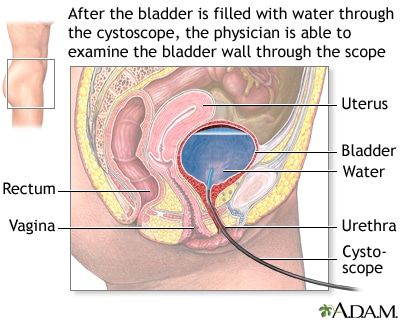Table of Contents
Cystoscopy is a surgical procedure to done to see the inside of the bladder using a thin, lighted tube. If your urologist also decides to look inside the ureter (a thin tube that drains urine from kidney into the bladder), the procedure is called ureteroscopy.
Why do I Need a Cystoscopy?
Cystoscopy is commonly done to:
- check for cancer of the bladder or urethra
- check the cause of blood in the urine
- diagnose the cause of problems passing urine
- diagnose the cause of repeated bladder infections
- help determine the cause of pain during urination
How is Cystoscopy Done?
Cystoscopy is done with an instrument called the cystoscope. This is a special tube with a small camera on the end (endoscope). There are two types of cystoscopes:
- Standard, rigid cystoscope
- Flexible cystoscope

The tube can be inserted in different ways. However, the test is the same. The type of cystoscope your health care provider will use depends on the purpose of the exam. The procedure will take about 5 to 20 minutes. The urethra is cleansed. A numbing medicine is applied to the skin lining the inside of the urethra. This is done without needles. The scope is then inserted through the urethra into the bladder.
Water or salt water (saline) flows through the tube to fill the bladder. As this occurs, you may be asked to describe the feeling. Your answer will give some information about your condition. As fluid fills the bladder, it stretches the bladder wall. This lets your provider see the entire bladder wall. You will feel the need to urinate when the bladder is full. However, the bladder must stay full until the exam is finished.
If any tissue looks abnormal, a small sample can be taken (biopsy) through the tube. This sample will be sent to a lab to be tested.
How to Prepare for the Test
Ask your provider if you should stop taking any medicines that could thin your blood.The procedure may be done in a hospital or surgery center. In that case, you will need to have someone take you home afterward.
How the Test will Feel
You may feel slight discomfort when the tube is passed through the urethra into the bladder. You will feel an uncomfortable, strong need to urinate when your bladder is full or a quick pinch if a biopsy is taken. After the tube is removed, the urethra may be sore. You may have blood in the urine and a burning sensation during urination for a day or two.
Normal Results
The bladder wall should look smooth. The bladder should be of normal size, shape, and position. There should be no blockages, growths, or stones.
What do Abnormal Results Mean?
The abnormal results could indicate:
- Bladder cancer
- Bladder stones (calculi)
- Chronic urethritis or cystitis
- Scarring of the urethra (called a stricture)
- Congenital (present at birth) abnormality
- Cysts (fluid filled structures)
- Diverticula of the bladder or urethra
- Foreign material in the bladder or urethra
- Bladder wall decompression
Some other possible diagnoses may be:
- Irritable bladder
- Polyps
- Prostate problems, such as bleeding, enlargement, or blockage
- Traumatic injury of the bladder and urethra
- Ulcer
- Urethral strictures
Are There Risks of Cystoscopy?
There is a slight risk for excess bleeding when a biopsy is taken. Other risks include:
- general risks associated with anesthesia or a surgical procedure like bleeding
- bladder infection
- rupture of the bladder wall
What Should I Do/Expect After the Procedure?
Drink 4 to 6 glasses of water per day after the procedure. You may notice a small amount of blood in your urine after this procedure. If the bleeding continues after you urinate 3 times, contact your provider.
Contact your provider if you develop any of these signs of infection:
- Chills
- Fever
- Pain
- Reduced urine output
Alternative Names
Cystourethroscopy; Endoscopy of the bladder
Last Updated: 02/27/2021 A
